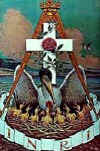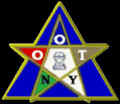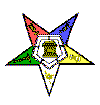Are
genetic defects -
price of
evolution?
Book
of Daniel
"Revelation" of John
The
signs of times
P104
The most
widespread Masonic
symbol is the
ruler with compasses
and a
letter "«G"
in
the centre.

Many beginners among masons believe , that "«G" - means: "«God". Only a Christian can question himself : what is common between God and a ruler with compasses. In a basis of the masons beliefs there is not bible truth, but a Gnostic doctrine. Their God is - not God, as we all see Him : the Almighty Father , but certain featureless incomprehensible thinkable energy - « the Great Architect of the Universe ».The intermediary between this energy and a man is the Lucifer, the master and the founder of this visible world.
 In fig.
-‘Let there be light!’ These words are of God from the Bible. Only this time
instead of the letter "G", which stands for the first letter of the
word "God" for many, here it is just a lamp.
In fig.
-‘Let there be light!’ These words are of God from the Bible. Only this time
instead of the letter "G", which stands for the first letter of the
word "God" for many, here it is just a lamp.
So
what does “G" mean in Masonic symbol?
It is "Geometry", and
more correct a secret geometry. That science, which was transferred to
them from the great-grandsons of Cain.
According to this occult doctrine the secret numbers have
special power, and with its help they can " order" some certain
events, i.e. influence the future.
Because of believe in secret geometry masons were always keen on geometry and
architecture. Hence, masons, as well as all pagans « worship and serve a
creature more than the Creator» (Rome 1:25): erect a science above the Most
High. «the science is My god!» is a
Masonic slogan. The open triangles
located one above another, in this symbol mean regeneration, infinity of life,
constant revival of nature in other
words: the sexual act, which is
worshipped by all pagans.
If masons do not believe in God, as the Person, it means that they do not believe also that Jesus is God (like Templars did not believe). For them Jesus is a common man who has achieved maximum degrees of education and has allowed the certain divine spirit named as «Consciousness of the Christ » to enter into him and to be led by him. Therefore Jesus could be anyone, who was ready to offer himself for the sake of others (even a pelican , as in figure below).
As
well as all pagan
religions, Freemasonry
recognizes an equal eternal opposition of two forces:
good and evil, therefore their god, the Lucifer, personifies both good and evil
simultaneously. “What is more absurd and more impious than to attribute
the name of Lucifer to the devil, that is, to personified evil. The intellectual
Lucifer is the spirit of intelligence and love; it is the paraclete, it is the
Holy Spirit, while the physical Lucifer is the great agent of universal
magnetism” **.
Knowing philosophical bases of Freemasonry, it will be easier for us now to understand real meaning of the most important Masonic symbols. So, the following and most used symbol is pentagrama, or a five-pointed star. It is an ancient magic sign. Sometimes it is represented by one ray upwards, sometimes - two rays upwards.
-----------------------------------------------------------------------
*Gnosticism
- the ideological hybrid of a pagan belief and Christianity invented by the
devil.
**Eliphas
Levi, «The Mysteries of Magic», p.428.


